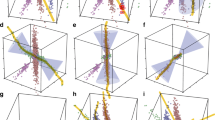Abstract
High-density DNA microarrays measure expression of large numbers of genes in one assay. The ability to find underlying structure in complex gene expression data sets and rigorously test association of that structure with biological conditions is essential to developing multi-faceted views of the gene activity that defines cellular phenotype. We sought to connect features of gene expression data with biological hypotheses by integrating 'metagene' patterns from DNA microarray experiments in the characterization and prediction of oncogenic phenotypes. We applied these techniques to the analysis of regulatory pathways controlled by the genes HRAS (Harvey rat sarcoma viral oncogene homolog), MYC (myelocytomatosis viral oncogene homolog) and E2F1, E2F2 and E2F3 (encoding E2F transcription factors 1, 2 and 3, respectively). The phenotypic models accurately predict the activity of these pathways in the context of normal cell proliferation. Moreover, the metagene models trained with gene expression patterns evoked by ectopic production of Myc or Ras proteins in primary tissue culture cells properly predict the activity of in vivo tumor models that result from deregulation of the MYC or HRAS pathways. We conclude that these gene expression phenotypes have the potential to characterize the complex genetic alterations that typify the neoplastic state, whether in vitro or in vivo, in a way that truly reflects the complexity of the regulatory pathways that are affected.
This is a preview of subscription content, access via your institution
Access options
Subscribe to this journal
Receive 12 print issues and online access
$209.00 per year
only $17.42 per issue
Buy this article
- Purchase on Springer Link
- Instant access to full article PDF
Prices may be subject to local taxes which are calculated during checkout






Similar content being viewed by others
References
West, M. et al. Predicting the clinical status of human breast cancer by using gene expression profiles. Proc. Natl. Acad. Sci. USA 98, 11462–11467 (2001).
Nevins, J.R. Toward an understanding of the functional complexity of the E2F and Retinoblastoma families. Cell Growth Differ. 9, 585–593 (1998).
Dyson, N. The regulation of E2F by pRB-family proteins. Genes Dev. 12, 2245–2262 (1998).
Coller, H.A. et al. Expression analysis with oligonucleotide microarrays reveals that MYC regulates genes involved in growth, cell cycle, signaling, and adhesion. Proc. Natl. Acad. Sci. USA 97, 3260–3265 (2000).
Bearss, D.J., Lee, R.L., Troyer, D.A., Pestell, R.G. & Windle, J.J. p21 WAF1/CIP1 deficiency has opposite effects in tumors arising from MMTV-Ras and MMTV-Myc transgenic mice. Cancer Res. 62, 2077–2084 (2002).
Lee, R.J. et al. Cyclin D1 is required for transformation by activated Neu and is induced through an E2F-dependent signaling pathway. Mol. Cell. Biol. 20, 672–683 (2000).
D'Crus, C.M. et al. c-MYC induces mammary tumorigenesis by means of a preferred pathway involving spontaneous Kras2 mutations. Nat. Med. 7, 235–239 (2001).
Pomeroy, S.L. et al. Prediction of central nervous system embryonal tumour outcome based on gene expression. Nature 415, 436–442 (2002).
Shipp, M.A. et al. Diffuse large B-cell lymphoma outcome prediction by gene-expression profiling and supervised machine learning. Nat. Med. 8, 68–74 (2002).
Golub, T.R. et al. Molecular classification of cancer: class discovery and class prediction by gene expression monitoring. Science 286, 531–537 (1999).
van'T Veer, L.J. et al. Gene expression profiling predicts clinical outcome of breast cancer. Nature 415, 530–536 (2002).
Nevins, J.R., DeGregori, J., Jakoi, L. & Leone, G. Functional analysis of E2F. Methods Enzymol. 283, 205–219 (1997).
DeGregori, J., Leone, G., Miron, A., Jakoi, L. & Nevins, J.R. Distinct roles for E2F proteins in cell growth control and apoptosis. Proc. Natl. Acad. Sci. USA 94, 7245–7250 (1997).
Bromberg, J.F. et al. Stat3 as an oncogene. Cell 98, 295–303 (1999).
Author information
Authors and Affiliations
Corresponding author
Ethics declarations
Competing interests
The authors declare no competing financial interests.
Rights and permissions
About this article
Cite this article
Huang, E., Ishida, S., Pittman, J. et al. Gene expression phenotypic models that predict the activity of oncogenic pathways. Nat Genet 34, 226–230 (2003). https://doi.org/10.1038/ng1167
Received:
Accepted:
Published:
Issue Date:
DOI: https://doi.org/10.1038/ng1167
This article is cited by
-
Methylglyoxal: a novel upstream regulator of DNA methylation
Journal of Experimental & Clinical Cancer Research (2023)
-
CircAGAP1 promotes tumor progression by sponging miR-15-5p in clear cell renal cell carcinoma
Journal of Experimental & Clinical Cancer Research (2021)
-
Lung tumorspheres reveal cancer stem cell-like properties and a score with prognostic impact in resected non-small-cell lung cancer
Cell Death & Disease (2019)
-
Fast dimension reduction and integrative clustering of multi-omics data using low-rank approximation: application to cancer molecular classification
BMC Genomics (2015)
-
Towards pathway‐centric cancer therapies via pharmacogenomic profiling analysis of ERK signalling pathway
Clinical and Translational Medicine (2015)



